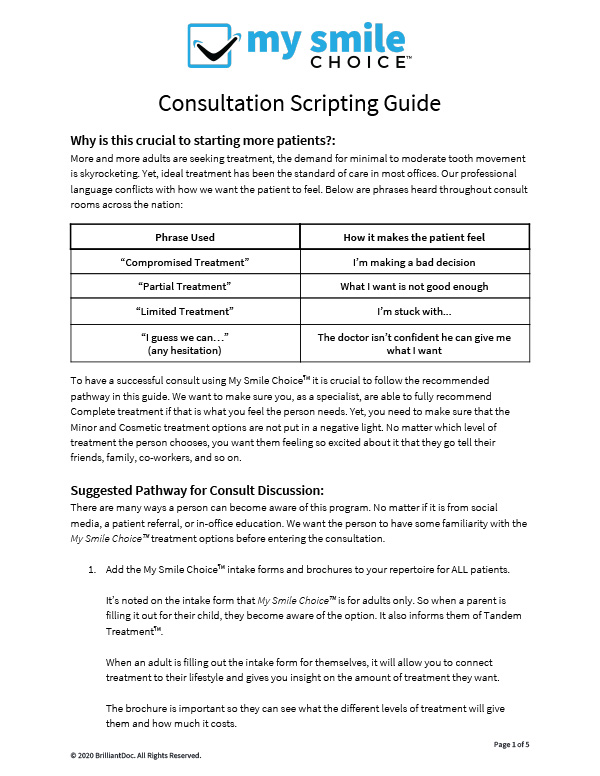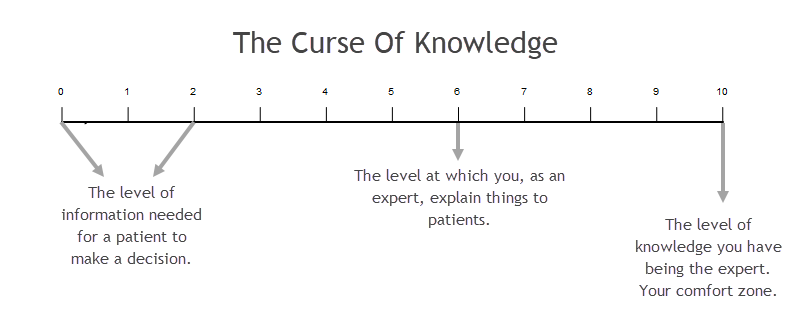Consultation Scripting Guide
Why is this crucial to starting more patients?
More and more adults are seeking treatment, the demand for minimal to moderate tooth movement is skyrocketing. Yet, ideal treatment has been the standard of care in most offices. Our professional language conflicts with how we want the patient to feel.
The Power of Words
Below are phrases heard throughout consult rooms across the nation, followed by how each makes a patient feel:
“Compromised Treatment”
I’m making a bad decision.
“Partial Treatment”
What I want is not good enough.
“Limited Treatment”
I’m stuck with…
“I guess we can…”
(any hesitation)
The doctor isn’t confident he can give me what I want
To have a successful consult using My Smile Choice™ it is crucial to follow the recommended pathway in this guide. We want to make sure you, as a specialist, are able to fully recommend Complete treatment if that is what you feel the person needs. Yet, you need to make sure that the Minor and Cosmetic treatment options are not put in a negative light. No matter which level of treatment the person chooses, you want them feeling so excited about it that they go tell their friends, family, co-workers, and so on.
Suggested Pathway for Consult Discussion
1. Add the My Smile Choice™ intake forms and brochures to your repertoire for ALL patients.
It’s noted on the intake form that My Smile Choice™ is for adults only. So when a parent is filling it out for their child, they become aware of the option. It also informs them of Tandem Treatment™.
When an adult is filling out the intake form for themselves, it will allow you to connect treatment to their lifestyle and gives you insight on the amount of treatment they want.
The brochure is important so they can see what the different levels of treatment will give them and how much it costs.
2. Take a scan of their teeth and/or any photos you may need.
You may want to take a few more photos than your typical composite. These views also help during the conversation:
- The anterior teeth slightly open – to see incisal wear
- Zoom in on the selfie shot or the “tooth of concern.”
- A “selfie shot” – many times people seek treatment because they don’t like how they look in photos. Remind them of that so they can show you what they don’t like. *You can make this one fun and connect to them as a “friend”
3. Proceed with your typical clinical evaluation.
4. Perform a simulation if you have that capability on your scanner.
TIP: The iTero® scanner shows a before and after treatment simulation. You can show a patient an idea of what Minor and Cosmetic treatment will give them by following these steps:
- Click “Invisalign® Outcome Simulator”
- To show the difference between Complete (with AP changes) and Cosmetic (straight teeth without AP changes) treatment, click “Treatment Goals” and select AP movement to show the bite difference.
- To Show a Minor treatment that will not fully straighten the teeth, click “Adjust Outcome.” From the occlusal view, move the anterior tooth of concern to its current position. Then fix it slightly, but not completely.
5. Show the MSC Consult Laminate provided that displays the 3 levels of treatment.
6. Use a transition statement such as, “we offer 3 levels of clear aligner treatment to make sure you get the smile you want. But my job is to help you look 1, 2, or 3 decades down the road. I’d like to make a recommendation based on what I see going on with your teeth. Would you mind if I give you my clinical opinion before we discuss all the options?”
7. Discuss the fully optimized course of treatment.
To open the discussion for Complete treatment, you’ll want to say something along the lines of, ““When I look inside your mouth, I assess more than just how your teeth are positioned. I look to see how your upper teeth and lower teeth bite together and evaluate if there are problems that need to be addressed. In your case, …”
Understand that the pricing will be a point of concern, even among those who can afford the Complete treatment option.
To build the most value for Complete treatment, you must tell the patient why you feel full treatment is needed. Here are some questions you’ll need to automatically answer in your consultation:
- Why do you feel Complete treatment is needed?
TIP: don’t get too clinical! Speak in terms a child will understand. For example, you may just say, “your bite is off…”
- How will Complete treatment affect the health of their mouth and overall health as they age?
- What are the negative consequences of not getting Complete treatment done (as compared to Cosmetic treatment)?
- How will Complete treatment impact their lives for the positive?
8. Ask a closing statement to your Complete treatment recommendation.
When you are done making your recommendation, there are many phrases you can use to see where the patient is in their decision process.
Some Examples:
- “What are your thoughts about what we just discussed?”
- “To truly solve the potential problems we discussed, Complete treatment is needed. Is that something you would be willing to consider?”
- “Knowing what you know now, does this sound like something you’d like to do?”
9. If the patient refers to the Consult Laminate and wants to discuss other treatment options:
When discussing the modified treatment options, again do not disparage one versus the other. They simply offer different value at different price points.
To connect best with a person’s emotional/Primal Brain, where most decisions are really made, their brain really “lights up” over stories to a much greater degree versus being given information. Therefore, an easy-to-understand metaphor is helpful when discussing alternative courses of action.
For example: a possible metaphor for 3 levels of orthodontic treatment could be thought of as being similar to a home remodeling project:
If you were going to remodel your home, there could be many projects that could ideally be done. If you are in a position to do everything at once, great. Do it all.
But that may not be possible for a variety of reasons. So, you may choose to do some projects, but not all. You select what works best for you at that time.
Or, it could be that of all the possible work that could be done, there is just one project that really bothers you and you want that one issue fixed.
There is nothing wrong with any of those choices, they are simply different.”
10. Once you’ve discussed an overview of the other two choices:
“Minor treatment is really for touch-ups… “
“Cosmetic treatment really addresses most of what needs to be done with your front teeth…”
…a final closing question is needed.
“Which approach sounds right for you?”
Now you are ready! Let us know how else we can support you and your practice. 🙂
–Your My Smile Choice™ Team

Sources:
Curse of Knowledge: https://en.wikipedia.org/wiki/Curse_of_knowledge


